These nudge marketing examples for email will propel your eCommerce strategy to infinity and beyond.
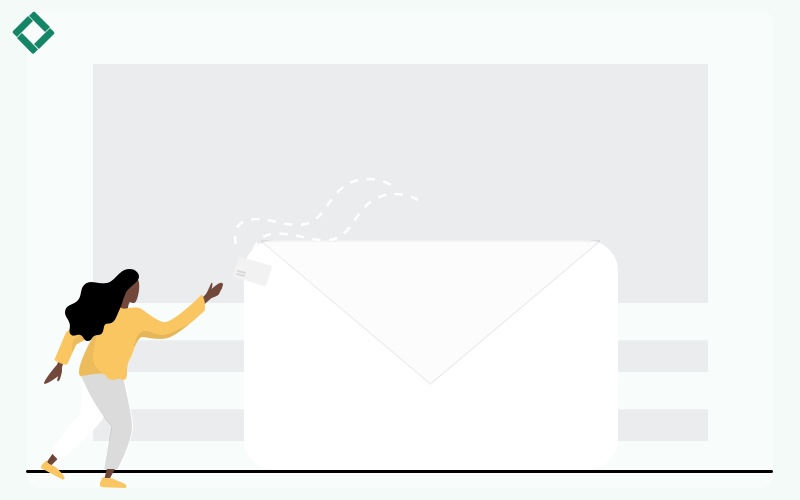
These nudge marketing examples for email will propel your eCommerce strategy to infinity and beyond.
Everyday we make small choices that impact our lives.
Should I take the elevator or the stairs to my office? Should we get Chinese takeout or burritos? Which color socks should I wear today?
Now imagine if you made each little decision in the same way you would choose to buy a house. You’d be exhausted.
You'd be late to the office, be hungry, and probably leave the house barefoot (at least I would, since I'm infamously indecisive).
This is why humans use shortcuts in their decision-making processes (or heuristics, which is just a fancier word for mental shortcuts).
By using external cues, focusing on the most relevant parts of a situation, and taking into account past experience, we can get a good idea of the best choice to make.
Which is where you, as a retail marketer, come in.
What if you could understand these shortcuts in order to influence people’s buying habits?
What if you could make these choices easier, faster, to leave your shoppers feeling better?
This is the essence of nudge marketing in behavioral economics: Facilitating quick decision-making to eventually create hassle-free experiences of your webshops.
Nudge marketing is all about subtly designing how you present your target audience with choices that encourage them to make decisions, without expressly incentivizing or forbidding any choice in particular.
In this article, I’ll show you 15 creative ways you can leverage nudge marketing in your email marketing strategy, using examples from some of the best emails I’ve seen.
Model these nudges in your own campaigns for more customer-centric marketing, engaging your subscribers and, of course, increasing conversions.
Abandoned carts are an eCommerce retailer’s worst nightmare.
According to Salecycle, 75.6% of all visitors to eCommerce stores add items to their cart, only to leave before purchasing them. It's no wonder, then, that emails meant to entice customers back to the checkout are so popular with marketers.
There are an almost infinite number of angles you can take in an abandoned cart email, but why not try a more subtle approach with a nudge?
Let's have a look at how the cosmetics brand Tarte does this.
Check out this subject line:

Rather than urging you to complete your order, or even mentioning that you’ve abandoned your cart at all, Tarte just wants to jog your memory that you were interested in one of their products.
Once you open the email, you see something like this:
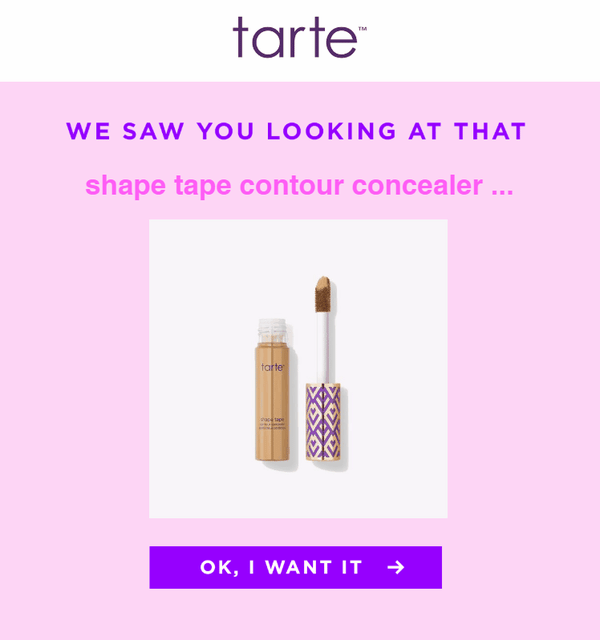
This call-to-action (CTA) is actually less of a CTA and more of an open invitation to customers to complete their purchase. It’s this lack of pressure that is key to good nudge marketing—you want to hand over the final decision to buy to the prospect.
That being said, make it easy for them to make the decision you want. This abandoned cart email does both:
By cutting out the whole process of finding the website, logging in, and then getting to the checkout, Tarte makes completing an order easier and more enticing.
Think of your email campaigns as just another step in your conversion funnel, to nudge people
through their customer journeys.
If you want to nudge someone into buying your product, you have to give them a reason. Oftentimes, this means understanding what they want, and how your product can provide that.
This you can work that out by analyzing your unique selling propositions (USPs) and leveraging them in your email campaigns. These might be functional benefits of your product, like being waterproof or ergonomic, or perks that are more psychological.
United By Blue used this tactic to promote a collection of backpacks to their subscribers. The company’s mission statement is to create sustainable clothes and accessories that are ethically manufactured, and they work these ideas into their promotional copy.
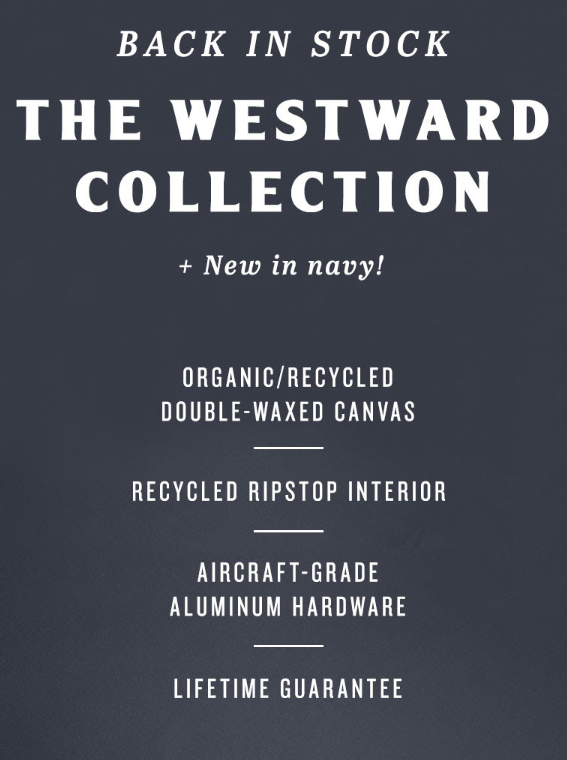
By including the fact that their backpacks are made from organic and recycled materials, they use the sustainability of their products to build people’s interest.
This triggers what’s known as the noble edge effect. By demonstrating genuine social goodwill as a company, this improves people’s perceptions of the brand and their products.
All of these things nudge people towards the goal of making a purchase. For more information on psychological marketing examples, read this post.
But it’s not just sustainability that works in this way. Product USPs can be:
Humans hate losing. Of course, winning is nice, but it’s always losing that seems to hurt us more and stay with us longer.
This means that we’ll do almost anything to avoid it, a phenomenon known in psychological terms as loss aversion. Scarcity, whether it’s an exclusive product, a limited-time discount or an item that’s low-in-stock, is the perfect trigger for loss aversion, and makes people much more likely to buy.
MAC Cosmetics understands this, and they make scarcity a pretty common feature in their campaigns. For example, I recently received an email from them with the following subject line:

Immediately, the urgency in this copy triggered my fear of missing out (FOMO) on these new lipsticks, and I just had to click through to find out more.
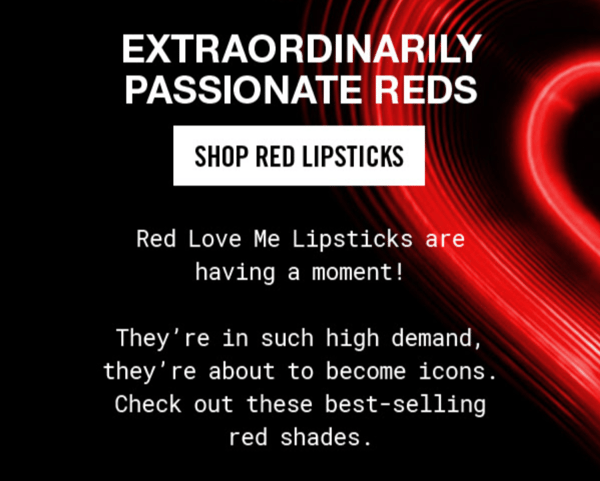
In this email, MAC also chooses to strive away from a sales-y pitch promoting the functional benefits of its product, which could easily feel disingenuous or manipulative.
Instead, they let the lipsticks’ popularity and scarcity speak for itself, by simply suggesting that I check them out. That being said, there’s a higher likelihood that, once I do, I’ll want to buy one while I can. But MAC allows me to get to that point on my own, with just a gentle nudge in the right direction.
Urgency is not the only tactic you can use in this way. There are several different types of scarcity that tend to resonate with different audiences and products, so choose wisely.
People often need proof that the claims you make in your nudge campaigns are genuine. It’s one thing to say that your products are popular, good quality and great value for money, but showing it is something else.
How can you do that? It's simple: let your customers speak!! Collect testimonials from fans and include them in your emails for the ultimate form of social proof.
Care/of, maker of personalized vitamin and supplement subscriptions, does just that in this email:
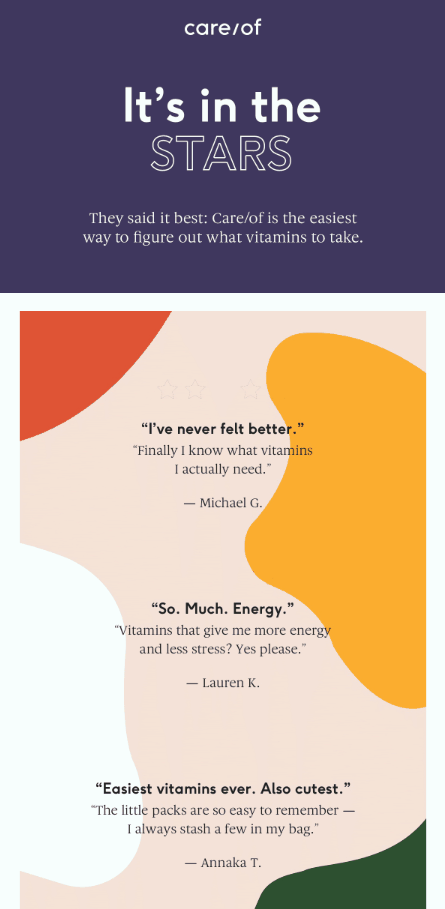
This tactic works especially well because they operate in a market full of skeptics. These testimonials nudge their subscribers towards a purchase decision by helping them overcome common potential objections to their product.
Even if what you’re trying to sell is not as controversial, customer testimonials are a fantastic way to improve people’s perceptions of you and your product. The more people like and trust you, the fewer doubts they’ll have about buying from you and the easier it will be to nudge them into doing so.
Sometimes people don’t buy from you because they simply don’t know what to get. If you’re offering a large number of items, or if all your products seem very similar, the amount of choice can become just too overwhelming.
One way you can overcome this problem is to recommend a selection of products and let your customers choose from those. This can be as simple as a list of your bestselling products. Or, you can get more complex by curating personalized lists based on your email segmentation.
Ban.do takes a different approach by creating a list of products recommended by a specific person:
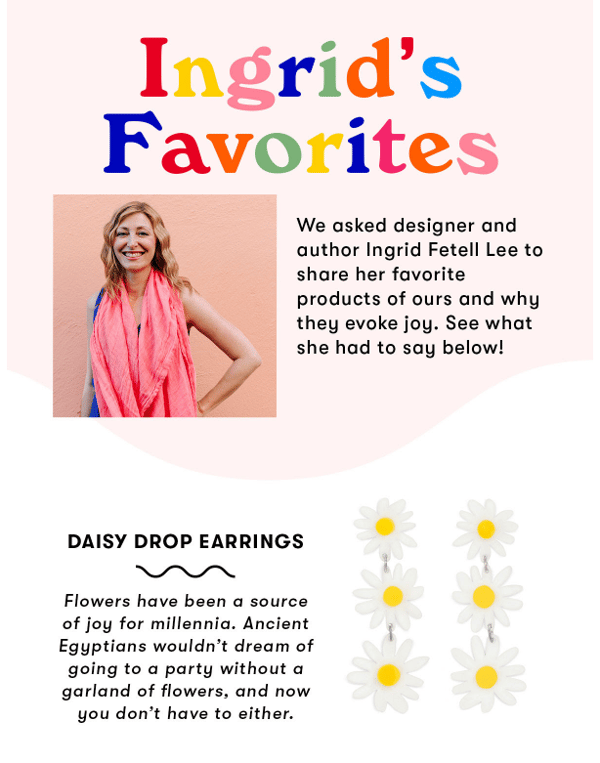
Even if you don’t know who Ingrid Fetell Lee is, this email tells you that she’s a designer. You can therefore gather that she probably has good taste, and would most likely be a good person to take product recommendations from.
Ban.do is making great use of authority here. Subscribers who are unsure of what to buy, or are just browsing, can read this email and trust in the opinions of someone who knows what they’re talking about.
While this strategy works well with the authority of an outside expert or influencer, you could also use your own brand as the authority. Present your product recommendations as suggestions from someone in your company who seems like they would know their stuff, and your subscribers will be more likely to take your advice.
If your subscribers are like most, they probably receive countless promotional emails over the course of a year. If you want your emails to get noticed amongst all the others, then you have to be smart about what you’re sending and when you do it.
You already send out specific emails for Black Friday and the festive season, and maybe for some other holidays too. But what about going even deeper? There are lots of opportunities throughout the year to market certain products in ways that will appeal to your subscribers.
Take this example from L'Oréal, who used the approaching fall season to engage with their customers and promote some of their products at the same time with this email:

I don't know about you, but towards the end of summer, I start to lament the weather getting colder and the nights drawing in.
But then I think of the autumn and everything feels brighter! This email campaign was sent out at the end of August. Perfect timing.
Also, the subject line doesn’t feel sales-y at all. Instead, it seems like there’s some helpful advice inside that you don’t want to miss out on.
Once you click through, you see this:
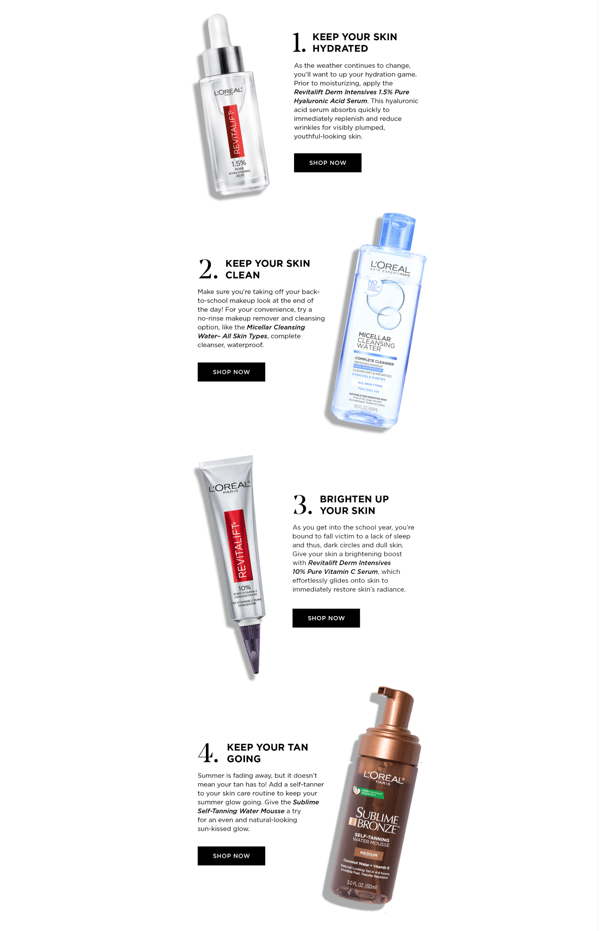
It’s a collection of L'Oréal products, but each is designed to tackle a specific pain point that comes with the changing seasons.
Number four, for example, targets those nostalgic feelings of a waning summer by offering a way to keep the look going for longer. That definitely got me thinking of my waning tan. And guess what? I bought the product. I took on fall. And thanked L'Oréal.
Take a minute to look at the products you offer and how they could be relevant at different times during the year. Of course, there are the four seasons to think about, but also different periods of social and industry cycles.
What about the back-to-school period, or the beginning of the year when everyone’s New Year’s resolutions are in full swing? There are year-round opportunities for some creative email campaigns.
Why are personality tests and astrological signs always so popular? Because we love to learn and talk about ourselves. That’s why emails addressing ‘you’ are so hard to resist.
There are few emails that are more customer-centric than emails about your customer loyalty program. By sending updates about your customers’ loyalty program progress, you satisfy their desire to gain more information about themselves while also nudging them toward making a purchase to make even more progress.
I like Abercrombie & Fitch’s loyalty program emails for their simplicity.
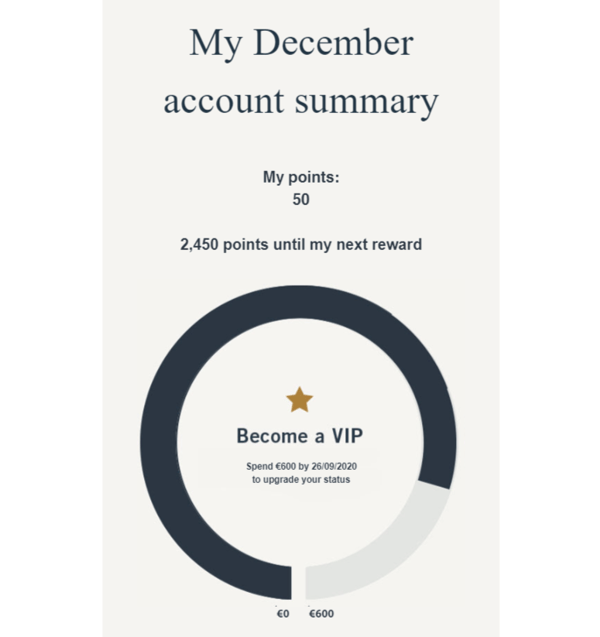
You get your current status, and how many points you need to reach for your next reward. Given our constant motivation as humans to seek out rewarding experiences, showing the end goal in these kinds of emails is a must.
What makes this email even more special is how they provide not only a points goal, but actual information about how much the customer would need to spend to reach it, as well as the deadline. Using real numbers and dates makes the reward, and the way to get there, more tangible and realistic.
In advertising, words like free, happy, love, save, passion, wonderful, joy, and winner are so-called God Terms.
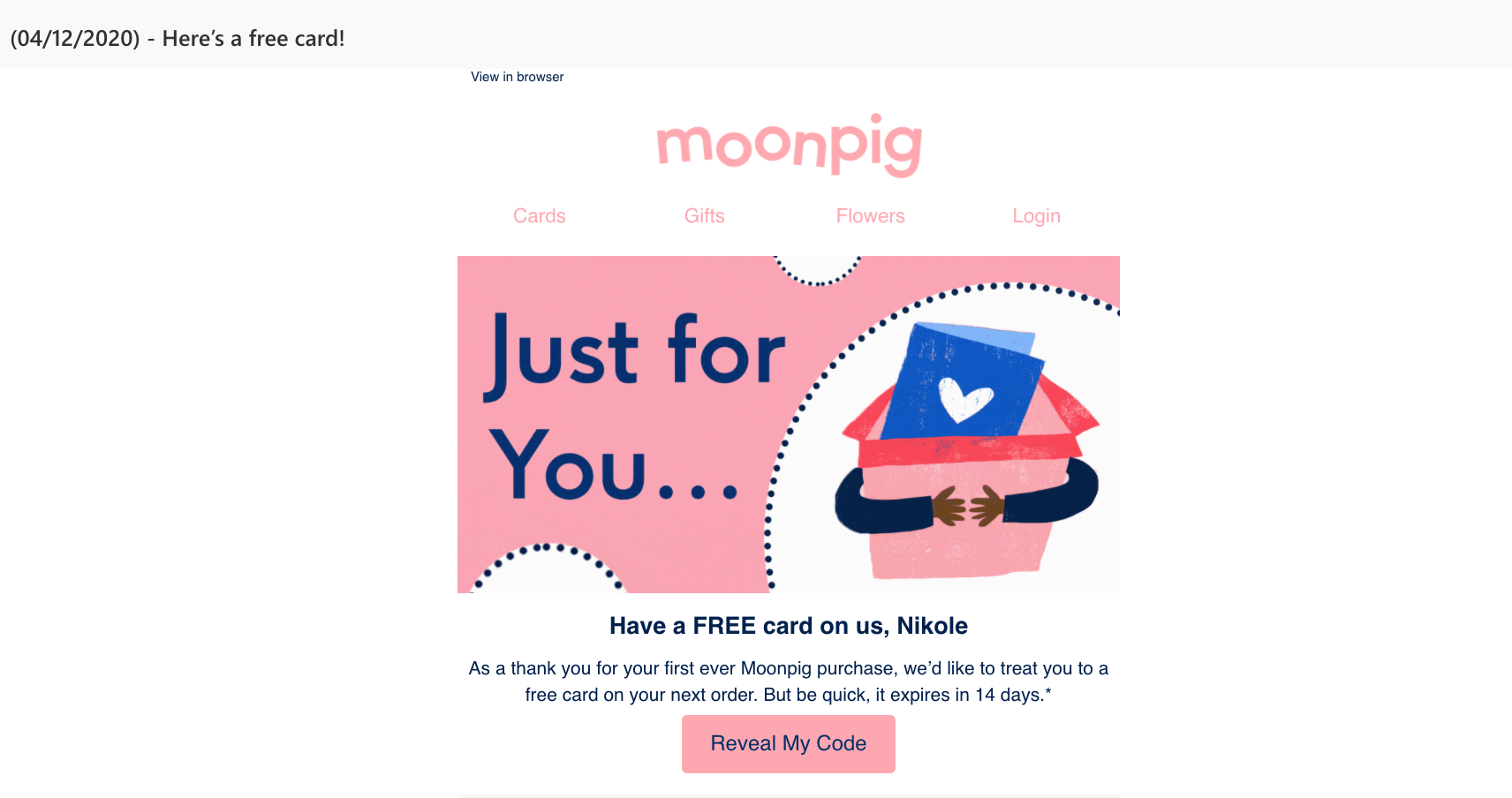
They are persuasive because they nudge the reader into a positive state of being. For example, when Moonpig proves a "FREE card", this is surprising for the shopper who is used to paying for their consumer goods. Plus, it will drive behavior to their webshop to check out this free gift.
Psychologically, "free" gifts, returns, or samples also inspire Reciprocity - the feeling of "an eye for an eye". If you give something away for free, this will nudge your shoppers to give something back (either a purchase, a click, or a browse).
Take a look at Free People's email campaign. What's great about this is how they underline both their brand and the USP of their winter products.
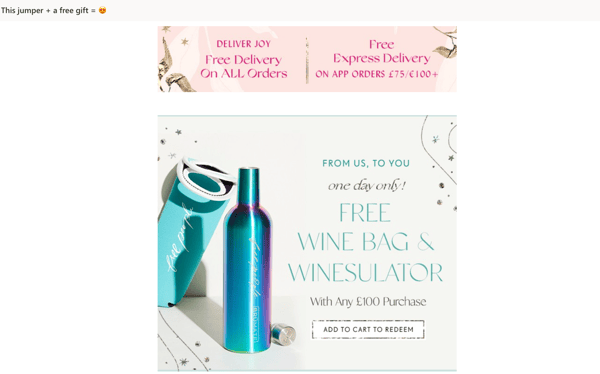
They also leverage "free gifts" at the peak of the gift-giving season. Meaning this nudge is both well-timed and persuasive.
You shouldn't overuse God Terms in your email campaign copy. However, this Free People email arguably "overuses" the word "Free" and yet still strikes a good balance by being in their tone of voice.
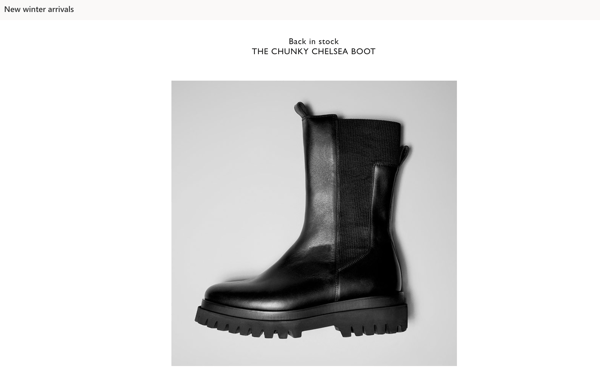
Re-targeting your customers based on their on-site behavior is another great way to leverage nudging.
For example, if a customer was browsing for a product that was previously out of stock, you can send them an email with the product when it's finally in stock. COS does this well, by retargeting the boot I recently browsed online in an email.
Sure, this will nudge your shoppers back to your webshop. But more than this, linking your PIMs to on-site behavior will enable you to reuse your product data in a way that's appealing to your customers.
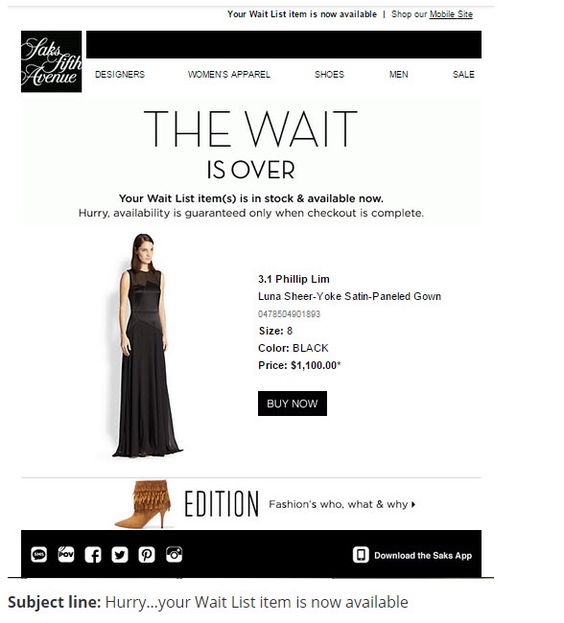
SAKS uses the same concept, but curates a whole email campaign around products their shoppers recently viewed and put on their "Wait List". Plus, they leverage Scarcity to drive behavior back to their webshop.
For more about analyzing on-site behavior for targeting, read about Behavioral Segmentation.
When our behavior doesn’t match previous beliefs, we tend to change our views in order for them to match our behavior. This is called Cognitive Dissonance, and can occur if you don't prime the idea that your shoppers love your products.

Urban Outfitters leverages this psychology in their subject line. By opening their email with a question, they prime the idea that they've curated products for me.
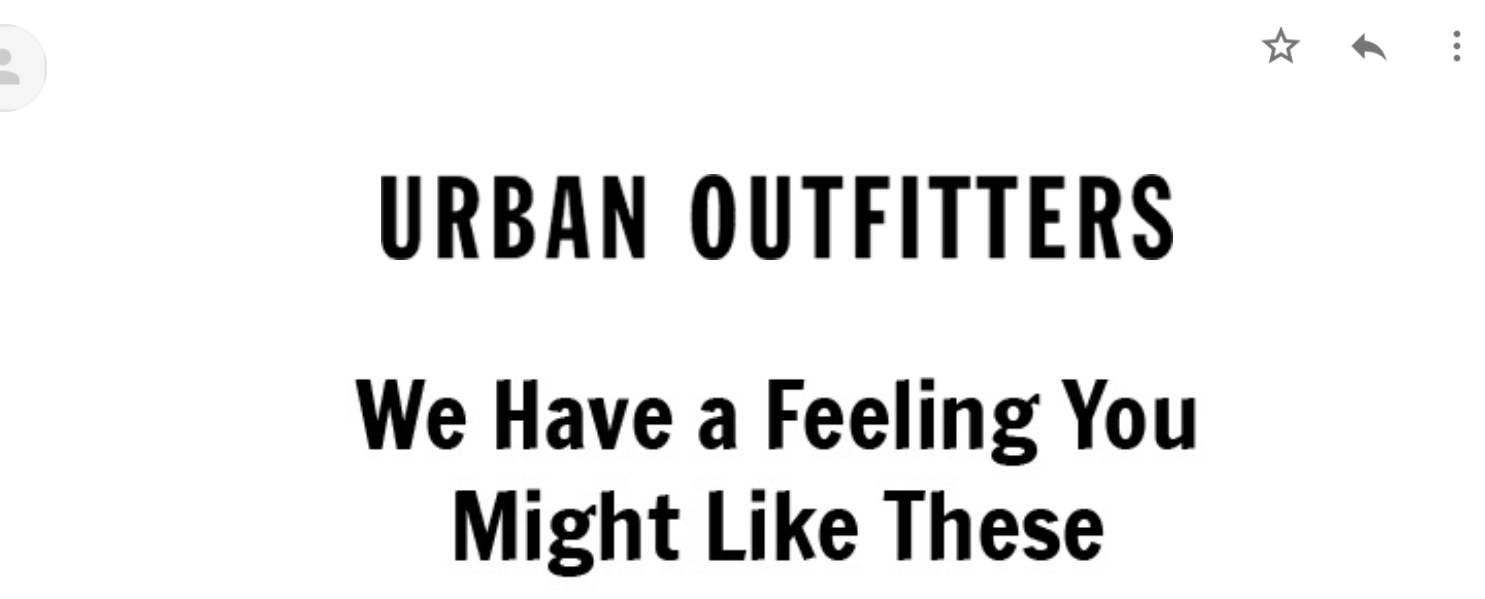
Then, by showing products they think I'll like, they prime the idea of sharing a personalized assortment, while increasing the likelihood that I will like the products "chosen".
Priming behavior is one way to nudge people in your emails campaigns, with "We think you'll like" or just by implying how a product will fit in your shopper's lives.
Nudge marketing is all about embracing the irrationality of your email subscribers. Sometimes, our choices aren’t always super informed or super logical, and that’s okay!
Incorporate some of these ideas into your email marketing strategy, and, soon enough, you’ll have subscribers that appreciate your brand, are interested in your products, and are willing to make purchases to show it.
This post was written by Sleeknote's Rachel Worthington
Rachel Worthington is a content marketer at Sleeknote: a company that helps eCommerce brand engage their site visitors, without hurting the user experience.
Read out Nudge Marketing ebook for more!